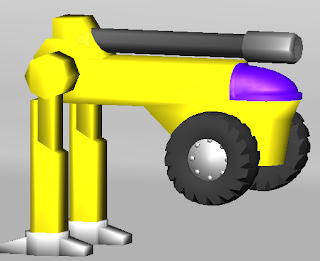But what is Poultron?
Let's start with where the idea came from. For some reason I was thinking of Power Rangers and realized it must have been hard to have each person in the team control a different part of the robot. I imagined it would be something like multiplayer qwop.Obviously such an idea can't go to waste. I quickly wrote up a small story (I'm weird like that):
The peaceful people of the planet Pa'inis realized the universe was eventually going to be attacked by an evil empire of anthropomorphic aliens (and by anthropomorphic I mean humans with a slightly blueish skin, but that's beside the point here). In order to defeat them they did what an ancient people focused on saving the universe usually do: build a huge modular robot which has to be assembled by different parts, each driven by a different teenager.
Soon, the rest of the universe followed suit and built there own robots just in case.
Eventually the evil guys came (they were pink) and the defence robots were activated. However by this point no one was entirely sure which parts belonged to which robot. Not to mention teenagers are not famous for their driving skills...
Eventually I found myself with no artist and had to lower my expectations: instead of a friendship crushing game I would have to settle for single player one (as I had no one to play with for every iteration I made).
The art style (or lack thereof)
While the decision to make this single-player (for now) fixed some of my immediate concerns, this still left me with another problem: the art style. I'm a |
| As you can see, this proves I'm indeed a programmer |
I started doing some sketches (slightly better than the one above) when it hit me: I could try going for an intentionally bad "made of paper" look for the whole game. I mean the whole idea was to make goofy looking robots doing goofy things. It took me around 5 entire seconds to sketch the parts of a robot and a couple of hours to crop the pieces, build some 2D shaders and put it together.
 |
| OH GOD KILL ME NOW |
So I went back to the drawing board and settled on another approach: I am fairly decent at making 3D models and animation but I suck at texturing. Maybe I can get by with a plastic-y/cartoonish look without too much effort.
 |
| Hopefully by the end of the day this thing will be doing things already |
STL information include no scale info, and the units are arbitrary. When you need to|you should|you have to} store colours and textures, the most effective 3D printing file isOBJ. OBJ can also be|can be} more succesful than STL when it comes to of|in relation to} describing geometries. 3D printable characters, famous folks, landmarks, animals, Male, feminine, monsters, aliens - it’s all here. Whether you’re printing utility automobiles to place on your table or creating miniatures in your tabletop games, it’s your category. Looking for fancy sculpture design recreating classical high precision machining works and statues of historic personalities, or inspiring figurines, perhaps even 3D-printable logos?
ReplyDelete